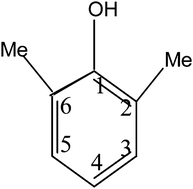The use of chemical shift calculations in the conformational analysis of substituted benzenes†
Abstract
The calculation of the 13C NMR chemical shifts of organic compounds by a combined molecular mechanics (Pcmod 9.1/MMFF94) and ab initio (GIAO (B3LYP/DFT,6-31+G(d)) procedure is used to determine the conformations of the substituted benzenes (PhX, X = CH2R, (R = Me, F, Cl, OH), OH, OMe, CO·Me, CO2Me) and their 4-Me,2,6-diMe,2,6-diF and 2-t-butyl derivatives; biphenyl and di-Cl and Me biphenyls). The 13C shifts are obtained from the GIAO isotropic shieldings (Ciso) with separate references for sp3 and sp2 carbons (δc = δref − Ciso). Comparison of the observed and calculated shifts provides information on the molecular conformations. Ethyl benzene exists as two equally populated conformers with the methyl planar and perpendicular to the benzene ring. In benzyl fluoride and chloride the halogen is perpendicular to the ring but benzyl alcohol has a number of possible conformations. The 13C shifts in phenol follow the equation. mae (mean absolute error) = 3.48 − 5.95·cos2 θ + 3.36·cos4 θ where θ is the OH/phenyl torsional angle. This function is almost constant between θ = 0° and 40° showing that the resonance interaction between the phenyl and OH π electrons is invariant from 0° to 40° torsion. This was also the case for the π-acceptors studied (PhX, X = CO·Me, CO2Me). In phenol, 2,6-difluoro and 2,6-dimethylphenol and anisole the planar conformer is preferred but the twisted conformer is favoured for 2,6-di-t-butylphenol and the perpendicular conformer for 2,6-dimethyl anisole. The 13C shifts of the 2-X-substituted phenols (X = Me, F, Cl, OMe, CN, NO2) are similar for the cis and trans conformers but the use of the 1H OH shift allows the OH cis/trans ratio to be obtained in these compounds. Acetophenone and methyl benzoate are planar but the substituent is perpendicular to the ring in the 2,6-dimethyl derivatives and twisted (ca. 30°–40°) in the 2,6-difluorocompounds. In biphenyl the dihedral angle of the phenyl rings is ca. 45° which increases to 90° in the ortho substituted biphenyls. These results are compared with other measurements of the molecular conformations.



 Please wait while we load your content...
Please wait while we load your content...